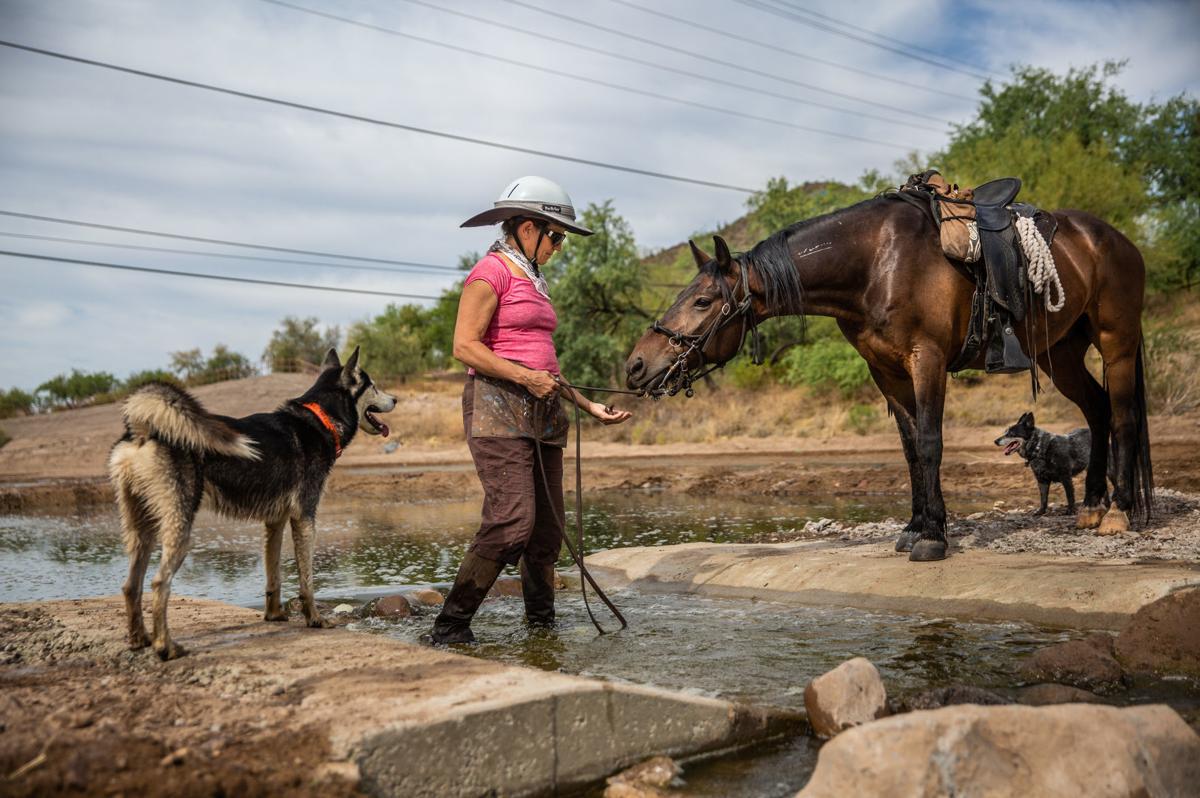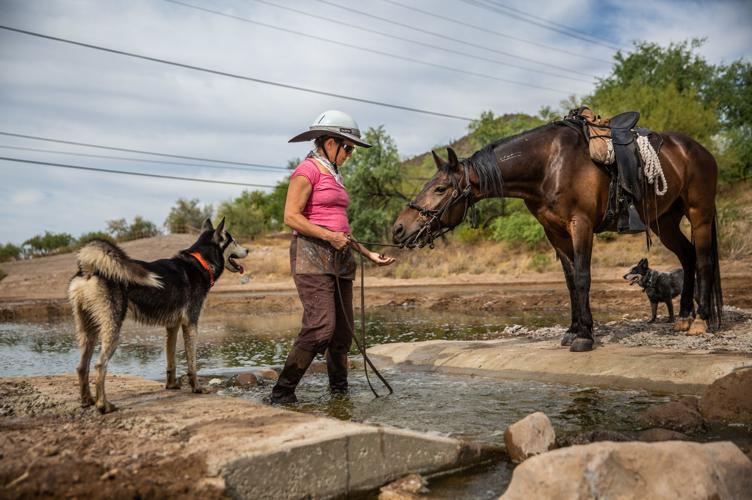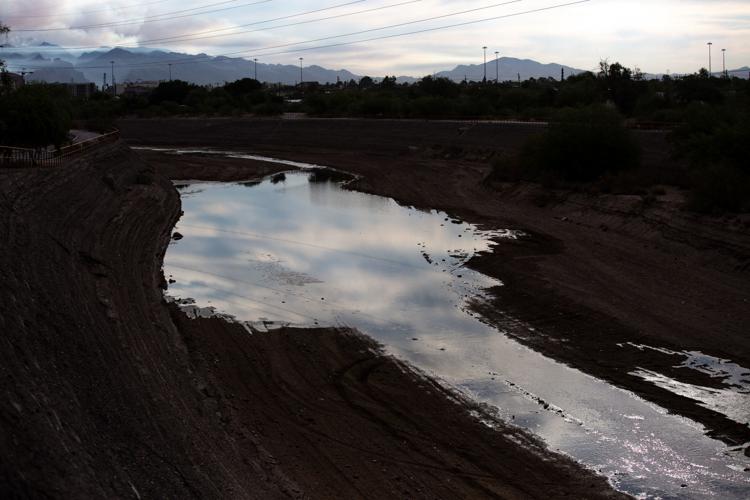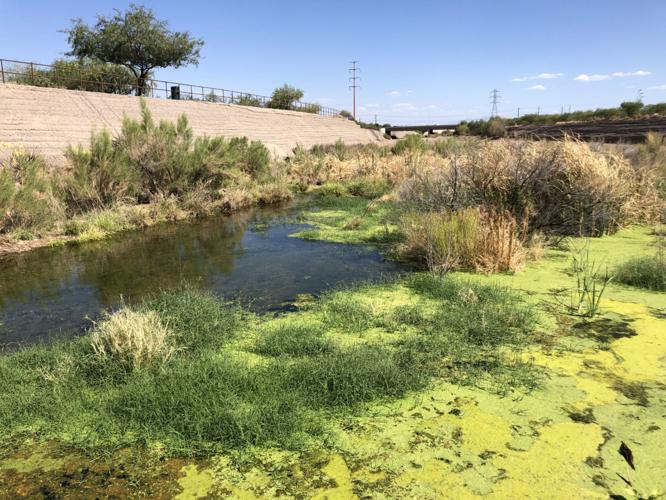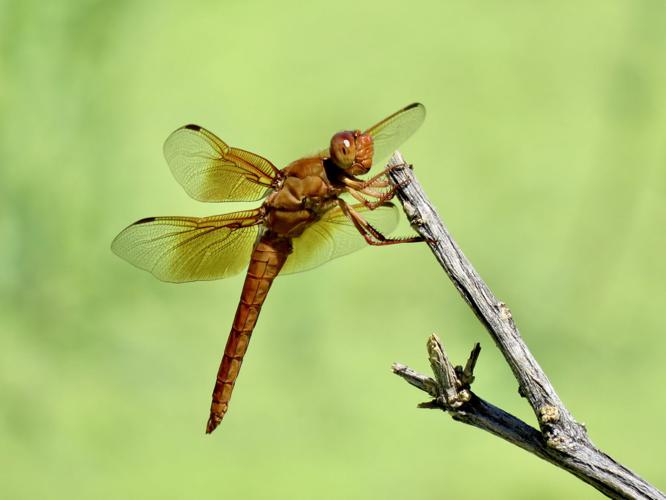Water is back in the Santa Cruz in downtown Tucson, drawing cattails, dragonflies and egrets, after the city kept the river dry since spring for sediment removal and other projects.
A steady stream, 10 or more feet wide in some places, runs downriver from 29th Street north to within a few hundred yards of Speedway.
Almost a year after Tucson Water first put reclaimed water back into the long-dead river, the Santa Cruz is carrying roughly the same amount as then, about 1,900 gallons a minute.
Two major hurdles that slashed, then stopped the water releases this year have been cleared, utility officials say.
First, Pima County flood control officials finished a monthlong project removing 83,000 cubic yards of sediment from the riverbed from West 29th Street north to West Cushing Street.
People are also reading…
The work that ended May 31 pulled out an average of 4 to 5 feet of riverbed, and as much as 10 feet in some spots. The project also removed about half the trees and other vegetation from the river stretch.
The other hurdle was that utility officials wanted to halt ÔÇ£pondingÔÇØ of the river water at about 22nd Street.
Officials said the ponding appeared to be a prime cause of a sharp spike in water levels in the underlying aquifer, rising fast enough to potentially undercut the old Rio Nuevo landfill lying west of the river between West 22nd and West Cushing streets. Officials need to ensure water in the aquifer doesnÔÇÖt leach contaminants from the trash, buried no lower than 25 to 30 feet below ground.

So far, 20 species of dragonflies have appeared along the Santa Cruz River near downtown.
The county obliged, installing small notches at a concrete grade control structure there and at three similar structures in the downtown area, allowing water to proceed more smoothly.
The notches ÔÇ£appear to be working, but we will continue to monitor their performance,ÔÇØ said Tucson Water spokesman Fernando Molina.
However, Eric Holler, a retired U.S. Bureau of Reclamation engineer and a frequent critic of the utility, said heÔÇÖs not convinced the notches have fixed problems with recharge of the aquifer. The rise in water levels ÔÇö exceeding 40 feet ÔÇö was so high that ÔÇ£the geology has to be weirdÔÇØ in that area, Holler said.
ÔÇ£This is going to be a work in progress as we manage this project,ÔÇØ Tucson Water Deputy Director John Kmiec has said. ÔÇ£We are still studying how the river will react.ÔÇØ
Reclaimed water was first put into the downtown stretch on June 24, 2019, to a crowd of several hundred wildlife lovers, politicians, agency officials and longtime residents who were thrilled to see full-time water in the river for the first time since World War II.
The purpose was to restore some of the riverÔÇÖs historic habitat and allow for recharge of the effluent in an area within Tucson WaterÔÇÖs service area, making it easier to someday pump it back out if itÔÇÖs ever needed for drinking or other domestic uses.
Vegetation and wildlife are returning after the riverÔÇÖs dry spell this year.

A red-spotted toad near West 29th Street, where effluent is being released, bringing more wildlife to the Santa Cruz River.
The birds and toads are back
A large wetland area that formed near 29th Street after the releases first started appears to be coming back. Green shoots of cattails are sprouting all over that area, next to yellowed marsh plants that died after the water releases were cut.
The birds, toads, roadrunners and other wildlife that had flocked to the area last year also have returned, said Michael Bogan, an assistant University of Arizona professor of natural resources who has been monitoring the riverfront for the past year.
ÔÇ£ThereÔÇÖs an accidental wetland here,ÔÇØ said Bogan, as he stood just above where four small channels of water were rippling through bright green trees and shrubs. ÔÇ£When the water was first released, the channel it created went toward some large tamarisk trees. The trees held the riverbank there in place, and kept it from eroding. That allowed the marsh to form. It was great, not part of anybodyÔÇÖs plan.ÔÇØ
After the county started removing sediment and the trees from the riverbed, Bogan was concerned that might let water speed away and cause the wetland to drain.
So with help from some of his students and Tucson Water volunteers, he spent five days in late May digging four separate channels to diffuse the waterÔÇÖs power and allow it to flow gently.

From left, a snowy egret eats a tadpole, a Great Plains toad calls for a mate and a flame skimmer dragonfly. Michael Bogan, an assistant natural resources professor at the University of Arizona, photographed wildlife on the Santa Cruz since Tucson Water started releasing effluent into the river again at the end of May.
ÔÇ£Now, it turns into kind of a delta,ÔÇØ he said. ÔÇ£The water spreads evenly.ÔÇØ
As for the wetland plants, Tucson Water planted one. The rest grew on their own, he said. This year, within 24 hours after the releases restarted, the plants had sprung back to life, he said. HeÔÇÖs counted six other plant varieties besides cattails, including sedges, manley flowers, pondweeds and speed wells.
Wildlife appears to be returning in the same pattern as last year, he said. So far, 20 species of dragonflies have appeared along the river. Sonoran toads were ÔÇ£breeding on Day 5,ÔÇØ and were followed by ÔÇ£thousandsÔÇØ of tadpoles on Day 7, he said. Great Plains toads showed up a few weeks later, and red-spotted toads appeared Friday.
The birds include killdeer, snowy egrets that eat toad tadpoles, and red-tailed hawks that one morning came in five strong to sip water.
The next variable will be the summer storm season, noted Molina, the Tucson Water spokesman.
ÔÇ£We expect the first substantial monsoon flows will move sediment around and create different flow pathsÔÇØ for the water.

Great Plains toad calling for a mate. Asst. Prof. Michael Bogan of the University of Arizona photographed wildlife on the Santa Cruz since Tucson Water started releasing effluent into the river again at the end of May 2020.

A red-tailed hawk drinking from the river. Asst. Prof. Michael Bogan of the University of Arizona photographed wildlife on the Santa Cruz since Tucson Water started releasing effluent into the river again at the end of May 2020.

Outfall marsh preservation area. Asst. Prof. Michael Bogan of the University of Arizona photographed wildlife on the Santa Cruz since Tucson Water started releasing effluent into the river again at the end of May 2020.

Flame skimmer dragonfly. Asst. Prof. Michael Bogan of the University of Arizona photographed wildlife on the Santa Cruz since Tucson Water started releasing effluent into the river again at the end of May 2020.
Historic photos of the Santa Cruz River:
30+ historic photos of the Santa Cruz River through Tucson

Waterfalls on the Santa Cruz River in 1889 near Sentinel Peak in Tucson.

Girls in Santa Cruz River,1889-1890.

A bridge over the Santa Cruz River near Sentinel Peak in Tucson washed out during flooding in 1915.

Santa Cruz River at St. Mary's Road bridge in 1931.

The Santa Cruz River flows north as seen from Sentinel Peak in Tucson in the early 1900's.

El Convento along the Santa Cruz River, ca. 1910.

Flooding of the Santa Cruz River, Tucson, in September, 1926, from ÔÇ£Letters from Tucson, 1925-1927ÔÇØ by Ethel Stiffler.

Flooding of the Santa Cruz River, Tucson, in September, 1926, from ÔÇ£Letters from Tucson, 1925-1927ÔÇØ by Ethel Stiffler.

Aerial view of the Santa Cruz River as it winds its way through Pima County north of Cortaro Road in 1953. The county was considering a bridge at several locations, but had to contend with the ever-changing course of the river.

The Tucson Citizen wrote in 1970, "The Santa Cruz River is a garbage dump" and "even marijuana grows in it." City leaders were pushing to upgrade and beautify the channel. The U.S. Army Corps of Engineers was studying the possibility.

The Santa Cruz River flowing under the Congress Street bridge in August, 1952. The Garden of Gesthemane is in the background.

By July 24, 1970 the old bridge on West Congress over the Santa Cruz River had to go and be replaced by a new bridge.

By July 24, 1970 the figures from Felix Lucero's Last Supper had been on the west side of the Santa Cruz River for more than 20 years. City authorities had decided to leave it in place while a new bridge on West Congress Street was to be replaced.

Volunteers from the Tucson Jaycees and Junior Chamber of Commerce finish restoration of the statues and grounds of the Garden of Gethsemane along the Santa Cruz River in May, 1964. The statues were ravaged by vandals and weather. The city parks and recreation department worked with the volunteers. Artist Felix Lucero began sculpture project in 1938 and finished it nine years later.

Drought in June, 1974, turned the Santa Cruz riverbed into crunchy chunks of dried mud.

The Santa Cruz River flowing under Silverlake Road in August, 1970.

Children play in the Santa Cruz River near Speedway Blvd in August, 1970.

The Santa Cruz riverbed at Congress Street in November, 1967.

After years of waiting, crews began clearing debris and channeling the Santa Cruz River in November, 1977, and constructing what would become a 14-mile river park. The Speedway Blvd. bridge is in the background.

After years of waiting, crews began clearing debris and channeling the Santa Cruz River in November, 1977, and constructing what would become a 14-mile river park.

The Santa Cruz River looks peaceful flowing underneath Speedway Road after days of flooding in October, 1977.

Adalberto Ballesteros rides along the Santa Cruz River west of downtown Tucson in 1980.

The Santa Cruz River looking north from Valencia Road in July, 1974.

Junked cars and trash spill into the Santa Cruz River, looking south, just south of Grant Road in July, 1974.

Road graders scrape the Santa Cruz River channel between Speedway and Grant roads during bank stabilization construction in May, 1991.

Water surges in the Santa Cruz River at the St. MaryÔÇÖs Road bridge on Oct. 2, 1983.

Flooding in Marana after the Santa Cruz River overflowed its banks in Oct. 1983.

A bridge on the Santa Cruz River northwest of Tucson washed out during flooding in October 1983.

Residents watch the surging Santa Cruz River rush past West St. Mary's Road on January 19, 1993. 

Tucson firefighters are standing by and waiting for two kids floating in the Santa Cruz River on some type of object during flooding in July, 1996.

As the Tucson Modern Streetcar rumbles across the Luis G. Gutierrez Bridge, water flows bank to bank along the Santa Cruz River after a morning monsoon storm on July 15, 2014.

Johnny Dearmore skips a rock in the Santa Cruz River as reclaimed water is released into the channel at 29th Street as part of the Santa Cruz River Heritage Project on June 24, 2019. The release of effluent is the cityÔÇÖs first effort to restore a fraction of the riverÔÇÖs flow since groundwater pumping dried it up in the 1940s.

The Santa Cruz River flows Friday morning July 23, 2021 after an overnight monsoon storm passed over in Tucson, Ariz.

Betsy Grube, center, with Arizona Game and Fish Department, releases longfin dace fish into the Santa Cruz River at Starr Pass Boulevard on March 23, 2022, as Mark Hart, right, takes a video and Michael Bogan, a professor in aquatic ecology at the University of Arizona, picks up more fish to release. The 600 fish were captured from Cienega Creek in Vail.


